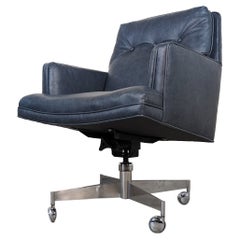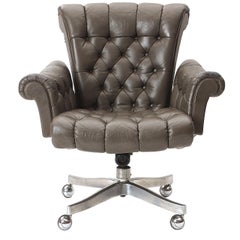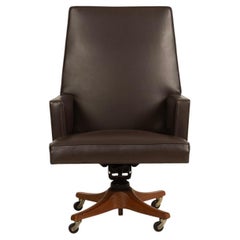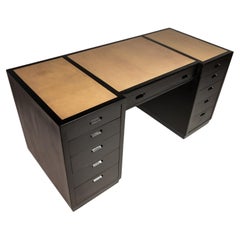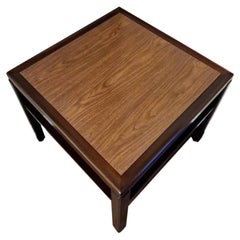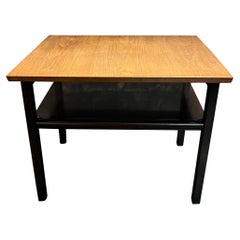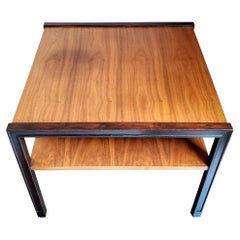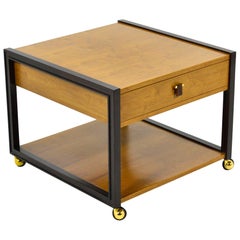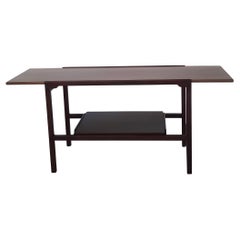Dunbar Office Furniture By Wormley
to
58
1,087
1,107
2
2
561
15
4
1
1
1,094
4
1
949
33
11
103
565
192
22
1
6
834
320
314
310
251
987
973
6
2
1
1,091
1,090
1,090
677
487
7
3
3
Sort By
Mid Century Executive Swivel Office Chair by Edward Wormley for Dunbar, 1950s
By Dunbar Furniture, Edward Wormley
Located in Chino Hills, CA
Edward Wormley for Dunbar, a testament to the era's innovation and Wormley's enduring influence on modern
Category
Vintage 1950s American Mid-Century Modern Office Chairs and Desk Chairs
Materials
Metal
$2,400 Sale Price
20% Off
H 35.5 in W 28.5 in D 28.5 in
Desk Chair by Edward Wormley for Dunbar
By Edward Wormley, Dunbar Furniture
Located in Sagaponack, NY
An adjustable and swiveling roll arm desk chair in the original brown leather, having a chromed four point base with casters.
Category
Vintage 1950s American Mid-Century Modern Office Chairs and Desk Chairs
Materials
Steel
Edward Wormley for Dunbar Executive Chair 1965
By Edward Wormley, Dunbar Furniture
Located in Chicago, IL
Edward Wormley for Dunbar Executive Chair 1965
This stunning executive chair designed by Edward
Category
Vintage 1960s American Office Chairs and Desk Chairs
Materials
Leather, Walnut
Ebonized Mid-Century Modern Executive / Campaign Desk by Edward Wormley
By Edward Wormley
Located in Deland, FL
Commanding and practical this impressive campaign-style desk by Dunbar has recently undergone a
Category
Vintage 1960s American Mid-Century Modern Office Chairs and Desk Chairs
Materials
Walnut
$15,360 Sale Price
20% Off
H 28.5 in W 60 in D 27 in
Vintage Edward Wormley for Dunbar Furniture Occasional Table
By Edward Wormley, Dunbar Furniture
Located in Forney, TX
Wormley (American, 1907-1995) for Dunbar Furniture; Berne, Indiana. Circa 1950-1965
A pair available
Category
Mid-20th Century American Mid-Century Modern End Tables
Materials
Brass
Mid-Century Walnut Occasional Table by Edward Wormley for Dunbar Furniture
By Dunbar Furniture, Edward Wormley
Located in Chicago, IL
Lovely occasional table circa 1950. Designed by Edward Wormley for Dunbar Furniture. This walnut
Category
Vintage 1950s American Mid-Century Modern End Tables
Materials
Leather, Walnut
$750
H 22.25 in W 28 in D 28 in
Mid-Century Edward Wormley for Dunbar Furniture Occasional Table
By Dunbar Furniture, Edward Wormley
Located in Forney, TX
doors of DUNBAR. A gifted designer and student of furniture history, Wormley inspired a global
Category
Mid-20th Century American Mid-Century Modern End Tables
Materials
Brass
Edward Wormley End Table by Dunbar
By Dunbar Furniture, Edward Wormley
Located in Highland, IN
A beautifully detailed table with great proportions, this Ed Wormley end table by Dunbar features a
Category
Vintage 1950s American Mid-Century Modern End Tables
Materials
Brass
Edward Wormley Console Table by Dunbar #5597
By Dunbar Furniture, Edward Wormley
Located in Fraser, MI
.
Designed by Edward Wormley.
Walnut infused formica top is a premium technology offered
by Dunbar in the
Category
Vintage 1950s Console Tables
Materials
Mahogany, Walnut
Console by Edward Wormley for Dunbar, 1950s
By Edward Wormley, Dunbar Furniture
Located in New York, NY
Wormley for Dunbar, 1950s. Retains original DUNBAR labels.
Category
Vintage 1950s American Mid-Century Modern Console Tables
Materials
Formica, Walnut
End Table by Edward Wormley for Dunbar
By Edward Wormley, Dunbar Furniture
Located in New York, NY
Edward Wormley End Table By Dunbar In Walnut Case And Shelf Supported By Mahogany Legs With Round
Category
Vintage 1960s American Mid-Century Modern End Tables
Materials
Brass
Cabinet 6026 by Edward Wormley for Dunbar
By Dunbar Furniture, Edward Wormley
Located in Dallas, TX
Beautiful and very elegant cabinet model # 6026 designed by Edward Wormely for Dunbar. This cabinet
Category
Mid-20th Century American Mid-Century Modern Bookcases
Materials
Brass
Magazine Table by Edward Wormley for Dunbar
By Edward Wormley, Dunbar Furniture
Located in Sagaponack, NY
A triangular ash table with an inset cream leather top over two web strap magazine holders.
Category
Vintage 1960s American Mid-Century Modern End Tables
Materials
Ash, Leather
End Table by Edward Wormley for Dunbar
By Edward Wormley, Dunbar Furniture
Located in Sagaponack, NY
A fine and uncommon pair of end tables having sculptural exposed frames in stained mahogany and expressive floating tops of molded birch with upturned edges.
Category
Vintage 1950s American Mid-Century Modern End Tables
Materials
Mahogany, Birch
Edward Wormley Ottoman for Dunbar
By Dunbar Furniture, Edward Wormley
Located in San Francisco, CA
Edward Wormley design x-base ottoman for Dunbar Furniture. Timeless and classic design by Wormley
Category
Vintage 1950s American Mid-Century Modern Ottomans and Poufs
Materials
Upholstery, Mahogany
Dunbar Single Arm Sofa Designed by Edward Wormley
By Edward Wormley, Dunbar Furniture
Located in Palm Desert, CA
This is a wonderful example of a period sofa by Edward Wormley for Dunbar Furniture. Circa 1960s
Category
Vintage 1960s American Mid-Century Modern Sofas
Materials
Fabric, Wood
Mahogany Writing Desk by Edward Wormley for Dunbar
By Dunbar Furniture, Edward Wormley
Located in Sagaponack, NY
An octagonal mahogany writing desk designed by Edward Wormley with a single drawer. Made by Dunbar
Category
Vintage 1950s American Mid-Century Modern Desks and Writing Tables
Materials
Mahogany, Walnut
Magazine Tree by Edward Wormley for Dunbar
By Edward Wormley, Dunbar Furniture
Located in Sagaponack, NY
An olive green stained walnut magazine tree with cantilevered shelves.
Category
Vintage 1940s American Mid-Century Modern Magazine Racks and Stands
Materials
Walnut
Edward Wormley Magazine Table for Dunbar
By Dunbar Furniture, Edward Wormley
Located in Dallas, TX
Magazine table by Edward Wormley for Dunbar, 1959. Constructed of oak, brass with inset leather top
Category
Vintage 1950s American Mid-Century Modern End Tables
Materials
Brass
Dunbar Edward Wormley Polygon End Table
By Edward Wormley, Dunbar Furniture
Located in New York, NY
A mahogany end table with polygon top. Made by Edward Wormley for Dunbar. USA, circa 1960. Signed
Category
Vintage 1950s American Mid-Century Modern End Tables
Materials
Wood, Mahogany
Janus' End Table by Edward Wormley for Dunbar
By Dunbar Furniture, Edward Wormley
Located in Sagaponack, NY
A walnut 'Janus' end table of Asian inspiration, with raised edges to the legs and diagonal cloud-lift stretchers.
Accented with green inlaid ceramic tiles.
Category
Vintage 1950s American Mid-Century Modern End Tables
Materials
Walnut
Wormley for Dunbar Cantilevered End Table
By Dunbar Furniture, Edward Wormley
Located in New York, NY
Cantilevered end table by Wormley for Dunbar. Original condition, and finish.We have separately
Category
Vintage 1950s American Mid-Century Modern End Tables
Tapered Leg Table by Edward Wormley for Dunbar
By Edward Wormley, Dunbar Furniture
Located in Sagaponack, NY
A tailored two-level square end or lamp table in walnut having splayed tapering legs.
Category
Vintage 1950s American Mid-Century Modern End Tables
Materials
Wood
Edward Wormley Side Table with Metal Detail by Dunbar
By Dunbar Furniture, Edward Wormley
Located in Highland, IN
In classic Wormley fashion, this walnut side table has very refined, subtle details. In this case
Category
Vintage 1960s American Mid-Century Modern End Tables
Materials
Metal
Edward Wormley for Dunbar Floor Lamp
By Dunbar Furniture, Edward Wormley
Located in St.Petersburg, FL
Floor lamp designed by Edward Wormley for Dunbar. Features a "snack" table base consisting of brass
Category
Vintage 1950s American Mid-Century Modern Floor Lamps
Materials
Brass
Clean Lined Console Table by Edward Wormley for Dunbar
By Dunbar Furniture, Edward Wormley
Located in Atlanta, GA
Clean lined console table, designed by Edward Wormley for Dunbar, American, circa 1960s. This table
Category
Vintage 1960s American Mid-Century Modern Console Tables
Materials
Mahogany, Walnut
Vanity or Desk by Edward Wormley for Dunbar
By Edward Wormley, Dunbar Furniture
Located in Sagaponack, NY
A solid wood double pedestal desk or vanity with demilune curve to accommodate seating and vertically stacked dowel drawer pulls.
Category
Vintage 1950s American Mid-Century Modern Desks and Writing Tables
Materials
Wood
Edward Wormley for Dunbar Custom Settee
By Edward Wormley, Dunbar Furniture
Located in Denton, TX
Financial for their office in Michigan. New upholstery may be desired.
Category
20th Century American Mid-Century Modern Settees
Materials
Upholstery, Ash, Rosewood
Occasional Wedge Table by Edward Wormley for Dunbar, C. 1950s
By Edward Wormley, Dunbar Furniture
Located in Westport, CT
The rarely found Wedge end table designed by Edward Wormely for Dunbar, circa 1950-1959. Executed
Category
Mid-20th Century American Mid-Century Modern End Tables
Materials
Leather, Walnut
Edward Wormley Round Travertine Side Table for Dunbar
By Dunbar Furniture, Edward Wormley
Located in Los Angeles, CA
Round side table by Edward Wormley for Dunbar, c.1950s, USA. This table features a round travertine
Category
Vintage 1950s American Mid-Century Modern End Tables
Materials
Travertine
Edward Wormley Lounge Chair with Ottoman by Dunbar, USA 1960s
By Edward Wormley, Dunbar Furniture
Located in Berlin, DE
Edward Wormley lounge chair with ottoman by Dunbar, USA 1960s
Dunbar lounge chair with ottoman
Category
Vintage 1960s American Mid-Century Modern Ottomans and Poufs
Materials
Fabric, Wood
$5,816 / set
H 31.5 in W 23.63 in D 31.5 in
Edward Wormley Travertine Wedge Side Table for Dunbar
By Edward Wormley, Dunbar Furniture
Located in Los Angeles, CA
Wedge shaped side table by Edward Wormley for Dunbar, c.1950s, USA. This end table features a
Category
Vintage 1950s American Mid-Century Modern End Tables
Materials
Travertine
Dining Set for Six by Edward Wormley for Dunbar
By Dunbar Furniture, Edward Wormley
Located in Sagaponack, NY
A drop-leaf console table opens to seat, six (6) for dining. Set complete with two banquette chairs and four side chairs.
Category
Vintage 1960s American Mid-Century Modern Drop-leaf and Pembroke Tables
Materials
Walnut, Upholstery
Edward Wormley for Dunbar Slate Pedestal Side Table
By Edward Wormley, Dunbar Furniture
Located in Virginia Beach, VA
Dunbar slate top side table consisting of black slate, solid mahogany, and a brass trimmed sabot
Category
Vintage 1960s American Mid-Century Modern Pedestals
Materials
Slate, Brass
Early Edward Wormley for Dunbar Step End Table
By Edward Wormley, Dunbar Furniture
Located in Los Angeles, CA
Three-tiered step up side table designed by Edward Wormley for Dunbar, circa 1950.
This table is
Category
Vintage 1950s American Mid-Century Modern End Tables
Materials
Walnut
Ebonized Mid Century Modern Armchair by Edward Wormley for Dunbar, c1960s
By Dunbar Furniture, Edward Wormley
Located in Chino Hills, CA
, crafted by the iconic Edward Wormley for Dunbar in the 1950s. This exquisite piece marries the
Category
Vintage 1960s American Mid-Century Modern Armchairs
Materials
Leather, Mahogany
$1,440 Sale Price
20% Off
H 32.5 in W 25 in D 28 in
Dunbar Office Furniture (Book)
Located in North Yorkshire, GB
office collection" which had been designed by Edward Wormley.
The introduction states that the
Category
Mid-20th Century Books
Materials
Paper
Mid-Century Executive Walnut Desk by Edward J. Wormley for Dunbar
By Dunbar Furniture, Edward Wormley
Located in North Hollywood, CA
Wonderful mid-century executive walnut desk designed by Edward J. Wormley for Dunbar in the United
Category
Vintage 1950s American Mid-Century Modern Desks and Writing Tables
Materials
Brass
Edward Wormley for Dunbar Janus Chair in Mohair
By Edward Wormley, Dunbar Furniture
Located in Dallas, TX
A dining height Janus armchair designed by Mid-Century Modern master Edward Wormley. The chair
Category
20th Century American Mid-Century Modern Side Chairs
Materials
Mohair, Mahogany
Dunbar Round Occasional Tables by Edward Wormley in Stainless Steel Midcentury
By Dunbar Furniture, Edward Wormley
Located in Philadelphia, PA
.
These tables have gone through an extensive restoration.
Edward Wormley worked in the same period as
Category
Mid-20th Century North American Mid-Century Modern End Tables
Materials
Stainless Steel
$6,950 / set
H 25 in Dm 30 in
Roll Top Writing Desk by Edward Wormley for Dunbar, 1960s
By Edward Wormley, Dunbar Furniture
Located in Sagaponack, NY
A stately and elegant rosewood and mahogany campaign desk having three drawers and two rosewood roll-top compartments flanking a central writing surface with a flip-down back splash,...
Category
Vintage 1950s American Mid-Century Modern Desks and Writing Tables
Materials
Brass
Roll Top Standing Desk by Edward Wormley for Dunbar, 1950s
By Dunbar Furniture, Edward Wormley
Located in Sagaponack, NY
A unique and elegant lectern in walnut with a roll top cover and a single drawer.
Category
Vintage 1950s American Mid-Century Modern Desks and Writing Tables
Materials
Walnut
Ingenious Console or Dining Table by Edward Wormley Dunbar Refinished Your Color
By Dunbar Furniture, Edward Wormley
Located in Atlanta, GA
Ingenious console or dining table, designed by Edward Wormley for Dunbar, American, circa 1950s
Category
Vintage 1950s American Mid-Century Modern Console Tables
Materials
Wood, Walnut
$2,850
H 29.25 in W 54 in D 17 in
Edward Wormley Dunbar Banded Mahogany Stepped Bookcase 1960s
By Dunbar Furniture, Edward Wormley
Located in Forest Grove, PA
A well made and designed bookcase by Edward Wormley for Dunbar and sold by Pioneer Furniture
Category
Vintage 1960s American Mid-Century Modern Bookcases
Materials
Mahogany
Edward Wormley for Dunbar Walnut Magazine Tree Table
By Dunbar Furniture, Edward Wormley
Located in Utrecht, NL
walnut, designed in 1947 for Dunbar Furniture USA.
A very special, functional and aesthetic small piece
Category
Vintage 1940s American Mid-Century Modern Magazine Racks and Stands
Materials
Birch, Walnut
Illuminated Globe Lamp by Edward Wormley for Dunbar (Featured in Catalog)
By Dunbar Furniture, Edward Wormley
Located in Chicago, IL
Globe Lamp attributed to Edward Wormley for Dunbar. Globe illuminates.
Illustrated in in Dunbar
Category
20th Century American Mid-Century Modern Globes
Materials
Wood
Edward Wormley Midcentury Two Level End Table for Dunbar
By Dunbar Furniture, Edward Wormley
Located in New York, NY
A single end table by Edward Wormley for Dunbar with square top and a fixed shelf rising on plinth
Category
Vintage 1970s American Mid-Century Modern End Tables
Materials
Wood
Rosewood and Mahogany Receptionist Desk by Edward Wormley for Dunbar, circa 1960
By Edward Wormley, Dunbar Furniture
Located in Los Angeles, CA
Wormley for Dunbar and features beautifully grained Rosewood and Ebonized Mahogany, designed and made in
Category
Vintage 1960s American Mid-Century Modern Desks and Writing Tables
Materials
Mahogany, Rosewood
$6,100 Sale Price
44% Off
H 46.5 in W 74.75 in D 28 in
Tambour Drum Table With Storage by Edward Wormley for Dunbar, 1944
By Dunbar Furniture, Edward Wormley
Located in Sagaponack, NY
A remarkable end table discreet bar with butterfly hinged top drawers and a tambour cabinet with adjustable shelf.
Category
Mid-20th Century American Mid-Century Modern End Tables
Materials
Mahogany
Tambour Door Storage Console with Drawer by Edward Wormley for Dunbar
By Dunbar Furniture, Edward Wormley
Located in Sagaponack, NY
A rare curved front console in rich grained rosewood with a single drawer and slatted tambour storage.
Category
Vintage 1950s American Mid-Century Modern Console Tables
Materials
Mahogany
Impressive Two Tier Triangular Wedge Table by Edward Wormley for Dunbar
By Dunbar Furniture, Edward Wormley
Located in Sagaponack, NY
A geometrically pure and finely detailed two-tiered table in bleached walnut of triangular form with distinctive beveled edging at a 45 degree angle.
Category
Vintage 1950s American Mid-Century Modern Console Tables
Materials
Walnut
$4,800
H 31 in W 60 in D 30 in
Edward Wormley for Dunbar Desk in Tawi Walnut & Steel
By Dunbar Furniture, Edward Wormley
Located in New York, NY
An exceptional and rare drop leaf desk by Edward Wormley for Dunbar in Tawi Walnut & Steel.
USA
Category
Vintage 1950s American Mid-Century Modern Desks and Writing Tables
Materials
Metal
Edward Wormley Dunbar End Table with Shelf, 2 Available
By Dunbar Furniture, Edward Wormley
Located in New York, NY
A mahogany end table by Edward Wormley for Dunbar. Two (2) available. Priced individually.
USA
Category
Vintage 1950s American Mid-Century Modern End Tables
Materials
Wood, Mahogany
Pair of Edward Wormley Green Leather Ottomans for Dunbar
By Edward Wormley, Dunbar Furniture
Located in Los Angeles, CA
Pair of ottomans by Edward Wormley for Dunbar, USA, c.1960s. The tufted seat cushions are
Category
Vintage 1960s American Mid-Century Modern Ottomans and Poufs
Materials
Leather, Mahogany
Mid-Century Walnut and Rosewood Executive Desk by Edward Wormley for Dunbar
By Edward Wormley, Dunbar Furniture
Located in Brooklyn, NY
Edward J. Wormely for Dunbar executive desk in walnut with deeply sculpted inset rosewood drawer
Category
Vintage 1950s American Mid-Century Modern Desks and Writing Tables
Materials
Brass
$4,800
H 29 in W 60 in D 32.35 in
Pair of Edward Wormley Walnut Side Tables for Dunbar, 1974
By Edward Wormley, Dunbar Furniture
Located in Hamburg, PA
These exquisite Dunbar walnut side tables, designed by the legendary Edward Wormley, epitomize Mid
Category
Vintage 1970s American Mid-Century Modern End Tables
Materials
Walnut
Desk by Edward Wormley for Dunbar
By Edward Wormley
Located in Dallas, TX
A mahogany desk with brass hardware and floating glass shelf. Designed by Edward Wormley for Dunbar.
Category
Vintage 1950s Desks
Materials
Mahogany
- 1
- ...
Get Updated with New Arrivals
Save "Dunbar Office Furniture By Wormley", and we’ll notify you when there are new listings in this category.
Dunbar Office Furniture By Wormley For Sale on 1stDibs
Choose from an assortment of styles, material and more with respect to the dunbar office furniture by wormley you’re looking for at 1stDibs. A dunbar office furniture by wormley — often made from wood, mahogany and walnut — can elevate any home. There are 1106 variations of the antique or vintage dunbar office furniture by wormley you’re looking for, while we also have 1 modern editions of this piece to choose from as well. There are many kinds of the dunbar office furniture by wormley you’re looking for, from those produced as long ago as the 20th Century to those made as recently as the 21st Century. A dunbar office furniture by wormley is a generally popular piece of furniture, but those created in mid-century modern, modern and Hollywood Regency styles are sought with frequency. Edward Wormley, Dunbar and Roger Sprunger each produced at least one beautiful dunbar office furniture by wormley that is worth considering.
How Much is a Dunbar Office Furniture By Wormley?
The average selling price for a dunbar office furniture by wormley at 1stDibs is $4,765, while they’re typically $75 on the low end and $58,800 for the highest priced.
More Ways To Browse
Honduran Mahogany Furniture
Retro 1950s Front Door
Drum Storage Table
Roll Top Desk 1960s
Detroit Furniture Company
Filing Cabinet On Wheels
Georgian Tea Cup
German Apothecary Jars
German Chime Clock
German Gun
German Nativity
German Wine Decanter
Gerome Bronzes
Giambologna Hermes
Giant Cabinet
Giant Shoe
Gilbert Sterling
Gilded Bronze Buddha
